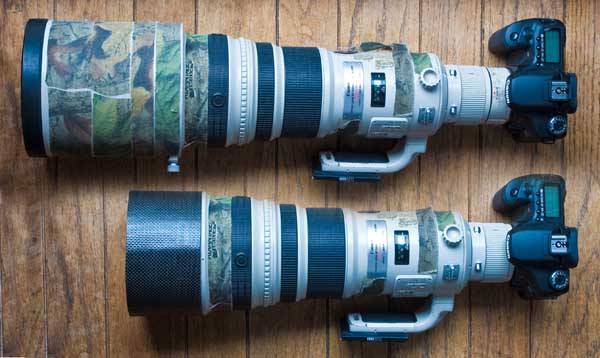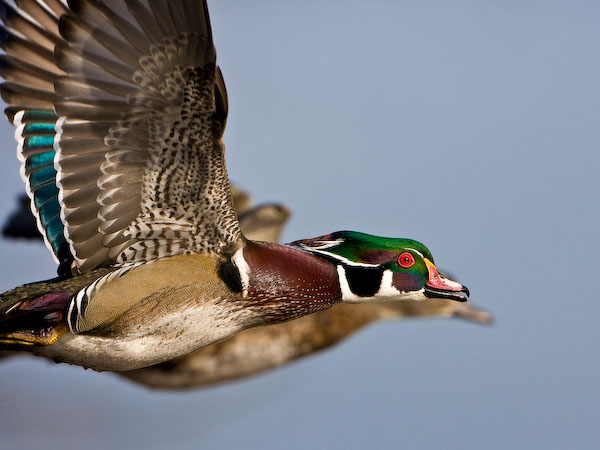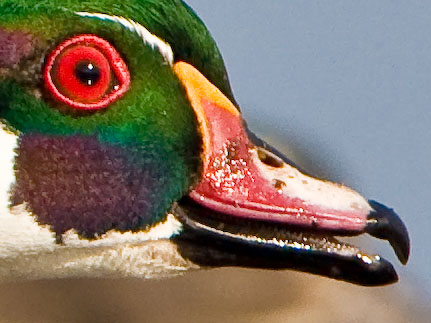
Another once unthinkable shift for outdoor wildlife shooters is handholding the big lens. Tripods have always been the rule for telephoto work, but in good light—even in the film days—handholding a medium-telephoto 300mm f/4 or 400mm f/5.6 for flight shooting was commonplace. Shoulder stocks or other aids helped smooth performance, as did electronic image stabilization. Shooting with a 500mm (mine weighs 8½ lbs.) lens required a tripod, good light or bad, aided by mounting the lens on a big ball-head or gimbaled Wimberley-type platform. These sturdy mounts yield the best chance of success. Or do they? If the goal is to get a crisp, sharp shot, maybe so—but how about a crisp, sharp shot that’s unique, hard to get, maybe even unimagined? The new crop of digital SLR’s—and some field choices—provide the kit to do the improbable.
Tripods can be cumbersome, and they sometimes get in the way. And what if you’re on a boat? Our world is two-thirds water. On a boat, a tripod magnifies engine vibration, and rocking from waves. Monopods do better, but only marginally. With high ISO digital for fast shutter speeds, with image stabilized lenses and with the multiplication factor built into most dSLR’s, handholding teles is a growing option. A new generation of wildlife shooters are stalking in parks with medium telephotos, aided by a 1.6x (or 1.5x to 2x) multiplier that turns a 300mm f/4 into a 480mm f/5.6, a nice reach. The gear is light enough to quickly find and track wildlife. If on a boat, there’s no need for additional support.

And bigger lenses? I photograph wildlife with a 500mm f/4, from Canon, usually with a full-frame 5D body and 1.4x tele-extender attached. The extender causes a one stop light loss, so that’s a 700mm f/5.6. It’s too big to handhold for general shooting, but most of my wildlife is shot from a sea kayak, where a tripod or even a monopod is impractical. I rest the lens on a deck bag (low angle!), which works much like using a beanbag when shooting from a vehicle (For you converts from hunting, using a gun rest bag would have similar results). For flight shooting, I shoot from the kayak handheld. I try to face forward (not always possible), sit upright, jam my elbows into my PFD (personal floatation device), and press my eye into the viewfinder. This works pretty well, but in solving a different problem, I recently made a big improvement to this set-up.
A huge concern I had was in transporting this kit in the cockpit. The kayaks I prefer to paddle are sea kayaks, with closed decks and smallish cockpits suitable for ocean travel. My Canon 500mm f/4 length—with 5D body, lens hood and 1.4x tele attached—is 24½”, including the 7” long, 8 oz. hood. It’s so long, the camera stretches from mid-thigh to my feet for transport.

This could be an entrapment issues should the kayak ever flip. But what if, I thought, I used a short hood? I came up with a suitably-sized test hood, a cylinder of plastic cut from a Costco nut container. It had a 5-3/4” diameter—just about right—and, after cutting off the top and bottom, the 3-1/2” length seemed spot on. I duct-taped the hood to the lens for a trial. It worked well, alleviating the transport issue. I could now shove the camera bag deep into the cockpit, enough out of the way that I could extract my feet without difficulty (yes, I actually did test this by flipping upside down). For the next step, a friend (Tim Walsh) volunteered his services. He had some scrap 3-3/8” wide carbon-fiber cloth and epoxy for the job. The round Costco hood became the mold. Tim cut the cloth to a slight overlap, gooped it with epoxy and laid on two layers. I’m leaving out a few details, but basically that’s it. The next day I placed two strips of a sticky-backed ¼” neoprene on the inside edge, and the new hood slid snuggly onto the lens. The final product weighs 2.2 oz.
Out in the field, I couldn’t have hoped for better. I can now shove the camera bag forward in the cockpit far enough so getting my legs out isn’t a worry. But here’s the kicker. I’ve switched from the full-frame 5D to the APS-C-sized 40D for wildlife, and shoot without the 1.4x (7.8 oz.) tele that slows autofocus and costs a stop of light. By the numbers, that gives me an 800mm (500 x 1.6) f/4, almost a pound lighter than the 700mm (500 x 1.4) f/5.6 that I had with the 5D. Autofocus with the 40D at f/4 is a huge improvement over the 5D at f/5.6, as is the 6 frames/sec (40D) is compared to 3 (5D). Lopping off the hood and tele probably doubled the time I can hold the camera up before tiring. It’s not so much the weight—a drop of less than a pound—but the “swing weight”: moving that long moment arm in toward my chest. And that’s made tracking the birds easier.The wood duck flight shot was from one of the first days out shooting the 40D handheld, sans tele-extender. It’s possible that I would have got that shot with the 5D and 1.4x attached, but not likely.
As digital imaging evolves, established ideas fall. It’s about taking it to the next level. The short hood solves a problem for me, and abets an up-and-coming trend.
Gary
Great! I have been looking for such a hood for years. So far I have been shooting without the hood as I think it is ridiculous and an overkill in terms of weight and lens and the fov is already such a narrow angle. Such I do not have any carbon fiber I will have to improvise. Thanks for showing that it is possible.
Andrew
A cheap alternate that works is to find the right sized plastic plant pot, cut the bottom out of it, and put a layer of sticky-sided neoprene on the inside to hold it in place. Other dark-colored cylinders could serve as well. The carbon fiber is light and looks good, but is otherwise no more functional.
Thanks for your suggestion.
BTW, Great BIF shots.